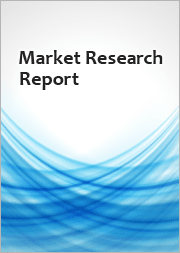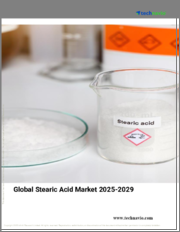
|
시장보고서
상품코드
1708084
세계의 스테아린산 시장 : 현황 분석과 예측(2024-2032년)Stearic Acid Market: Current Analysis and Forecast (2024-2032) |
||||||
세계의 스테아린산 시장 규모는 화장품 및 퍼스널케어 산업 수요 증가와 지속가능한 식물 유래 대체품으로의 전환 증가로 인해 예측 기간 중 연평균 7.1%의 견고한 성장세를 보일 것으로 예상됩니다. 시장은 중국, 인도, 동남아시아 등의 국가들이 빠르게 산업화하고 소비재 및 제조 산업에서 제품 사용을 확대함에 따라 개발도상국 시장에서 급성장할 것으로 예상됩니다. 이들 지역에서는 개인 소비가 빠르게 증가하고 있으며, 스테아르산 제품을 사용하는 퍼스널케어, 자동차, 섬유 부문의 발전을 촉진하고 있습니다. 인도는 소비자들이 지속가능한 제품을 받아들이고 화장품 제조가 확대되면서 스테아린산의 주요 타겟 시장이 되고 있습니다. 세계 제조의 중심지인 중국은 산업 발전 사이클을 통해 스테아르산 수요를 지속적으로 증가시키고 있습니다. 이들 지역은 현지 생산 작업에서 이익을 얻는 반면, 국제 기업은 빠르게 성장하는 경제권에서 시장 점유율을 확보하기 위해 투자하고 있습니다.
원료에 따라 시장은 동물성 및 식물성으로 분류됩니다. 이 중, 식물성 원료 시장은 상당한 CAGR로 성장하고 있습니다. 식물성 스테아르 산이 고객에게 선택되는 이유는 미용, 셀프 케어 및 식품 생산 시장에서 친환경 제품을 지원하기 때문입니다. 사람들이 지구를 보호하는 데 기여할 때 동물성 제품 대신 식물성 원료를 사용하기로 선택합니다. 고객의 선택 패턴의 변화는 기업이 환경 및 품질 기준에 따라 바이오 제품을 생산하고 규제하도록 유도합니다. 시장이 식물성 스테아린산을 환영하는 이유는 환경을 중시하는 기업이 지속가능성 이점과 윤리적 조달을 선호하기 때문입니다.
용도에 따라 스테아르산 시장은 비누 및 세제, 퍼스널케어, 고무 가공, 섬유, 윤활유, 기타로 분류됩니다. 비누 및 세제 부문은 예측 기간 중 높은 CAGR을 기록했습니다. 비누 및 세제에 스테아르산이 필요한 주요 이유는 제품 성분의 유화 및 농축 작용과 함께 계면활성제로서 효과적으로 작용하기 때문입니다. 스테아린산은 더 큰 기포 작용을 가능하게 하면서 유동성을 조절하므로 비누 및 세제는 고품질의 가죽과 두께를 위해 스테아린산을 필요로 합니다. 이 화학물질은 얼룩과 오일때를 쉽게 제거하여 세제의 세정 작용을 돕습니다. 스테아르산은 비누 및 세제에 사용될 때 효과적이고 지속가능한 포뮬러에 대한 고객의 요구를 충족시키기 위해 세제 개발에 중요한 역할을 합니다.
아시아태평양의 스테아르산 시장은 주로 중국, 인도, 일본, 한국이 사용하는 명확한 시장 전략에 의해 운영되고 있습니다. 중국은 대규모 제조 부문이 표면 처리 요구 사항과 윤활 요구 사항을 화장품과 결합하여 스테아르산 제조 시장과 소비자 시장을 모두 지배하고 있습니다. 인도는 스테아르산 공급을 유지하기 위해 농장에서 팜유를 생산하고 있습니다. 인도에서는 현재 중산층에서 고급 퍼스널케어 제품을 구매하는 사람들이 증가하고 있으며, 동시에 비누 및 세제 구매도 증가하고 있습니다. 인도는 농업이 활발하므로 팜유와 야자유에서 식물성 스테아르산을 대량으로 생산할 수 있습니다. 고도로 발달하고 성숙한 시장을 가진 일본은 화장품, 의약품, 전자기기 등 고품질 용도에 중점을 두고 있으며, 천연 식물 유래 성분에 대한 수요가 증가하고 있습니다. 한국의 스테아린산은 한국의 뷰티 제조업체들이 보다 친환경적인 제품을 개발하고 시장에서의 성공을 위해 노력하고 있으므로 더 크게 성장할 필요가 있습니다. 한국 공장은 다양한 산업 활동에서 스테아르산을 가장 많이 사용하고 있습니다. 이들 국가는 공통 시장을 구축하기 위해 활동을 조정하고 있으며, 중국과 인도가 생산을 주도하는 반면 일본과 한국은 환경 친화적인 산업 활동을 확립하고 있습니다.
시장에서 활동하고 있는 주요 기업은 BASF SE, 3F Industries Ltd., New Japan Chemical Co. Ltd., Oleon NV, Wilmar International, Emery Oleochemicals, Cayman Chemical, Twin Rivers Technologies, Kao Chemicals, KLK Oleo 등입니다.
세계의 스테아린산 시장에 대해 조사했으며, 시장 역학, 지역과 부문의 분석, 기업 개요 등을 제공하고 있습니다.
목차
제1장 시장의 서론
제2장 조사 방법 또는 전제조건
제3장 개요
- 산업 요약
- 부문 전망
- 시장 성장 강도
- 지역 전망
제4장 시장 역학
- 촉진요인
- 기회
- 억제요인
- 동향
- PESTEL 분석
- 수요측 분석
- 공급측 분석
- 합병과 인수
- 투자 시나리오
- 산업 인사이트 : 주요 스타트업과 독자적인 전략
제5장 가격 분석
- 지역의 가격 분석
- 가격에 영향을 미치는 요인
제6장 세계의 스테아린산 시장 매출(2022-2032년)
제7장 시장 인사이트 : 원료별
- 동물성
- 식물성
제8장 시장 인사이트 : 용도별
- 비누·세제
- 퍼스널케어
- 고무 가공
- 텍스타일
- 윤활유
- 기타
제9장 시장 인사이트 : 지역별
- 북미
- 미국
- 캐나다
- 기타 북미
- 유럽
- 독일
- 영국
- 스페인
- 프랑스
- 이탈리아
- 기타 유럽
- 아시아태평양
- 중국
- 인도
- 일본
- 한국
- 기타 아시아태평양
- 기타 국가
제10장 밸류체인 분석
- 한계 분석
- 시장 참여 기업 리스트
제11장 경쟁 구도
- 경쟁 대시보드
- 경쟁 시장 포지셔닝의 분석
- Porter's Five Forces 분석
제12장 기업 개요
- BASF SE
- 3F Industries LTD
- New Japan Chemical Co. Ltd.
- Oleon NV
- Wilmar International
- Emery Oleochemicals
- Cayman Chemical
- Twin Rivers Technologies
- Kao Chemicals
- KLK Oleo
제13장 두자어와 전제조건
제14장 부록
KSA 25.05.07Stearic acid stands as a major subfield of the chemical industry that people use widely across cosmetics, personal care, pharmaceuticals, food, and industrial applications. Stearic acid from saturated fatty acids becomes available through both animal fats and vegetable oils yet the industry prefers vegetable oil because of environmental reasons. Personal care companies need more stearic acid as their product manufacturing requires it to control product textures and prepare mixtures with it. By functioning as a manufacturing substance in multiple processes it has extended its practical uses. People now choose plant-derived stearic acid to make products more eco-friendly and these customer preferences push market expansion across all industries.
The Stearic Acid Market is expected to grow at a robust CAGR of 7.1% during the forecast period, owing to the rising demand from cosmetics and personal care industries, and the increasing shift toward sustainable, plant-based alternatives. The stearic acid market will grow quickly in developing regions since countries like China, India, and Southeast Asia industrialize rapidly and consumer goods and manufacturing industries expand their use of the product. Consumer spending is rising fast in these areas driving personal care, automotive, and textile sector development which uses stearic acid products. India stands as a leading target market for stearic acid because its cosmetic manufacturing is expanding while consumers embrace sustainable products. As a worldwide manufacturing center, China keeps increasing its demand for stearic acid through its industrial development cycle. These areas receive benefits from local production operations while international companies invest to gain market share in fast-expanding economies.
Based on Feedstock, the market is categorized into Animal-based and Vegetable-based. Among these, the Vegetable-based feedstock market is growing with a significant CAGR. Customers choose vegetable-based stearic acid because it supports eco-friendly products across beauty, self-care, and food production markets. When people dedicate themselves to Earth's defense they choose to use plant materials in place of animal products. The shift in customer choice patterns encourages companies to make and regulate bio-based products according to environmental and quality standards. The market welcomes vegetable stearic acid derived from plants because companies with an environmental focus love its sustainability benefits and ethical sourcing.
Based on Application, the Stearic Acid market is divided into Soaps & Detergents, Personal Care, Rubber Processing, Textile, Lubricants, and Others. The Soaps & Detergents segment registered a significant CAGR during the forecast period. The main reason soaps and detergents need stearic acid is because it works effectively as a surfactant along with acting to emulsify and thicken product ingredients. Soaps and detergents require stearic acid for high-quality leather and thickness because it controls fluidity while enabling greater foaming action. The chemical assists in cleaning actions of detergents by making dirt and grease easier to remove. Stearic acid plays a key part in cleaning product development because it satisfies customer needs for effective and sustainable formulas during its use in soaps and detergents.
For a better understanding of the market adoption of the Stearic Acid industry, the market is analyzed based on its worldwide presence in countries such as North America (U.S.A., Canada, and Rest of North America), Europe (Germany, United Kingdom, France, Spain, Italy, and Rest of Europe), Asia-Pacific (China, Japan, India, South Korea, and Rest of Asia-Pacific), Rest of World. The APAC stearic acid market operates mainly through distinct market strategies used by China, India, Japan, and South Korea. China dominates both stearic acid manufacturing and consumer markets because its mass manufacturing sector combines cosmetics with surface treatment needs and lubrication requirements. The country produces palm oil from its agricultural farms to maintain its supply of stearic acid. More individuals from the middle class in India now buy upscale personal care products at the same time they purchase more soaps and detergents. India can produce lots of vegetable stearic acid from palm and coconut oil since agriculture remains strong in the country. Japan, with its highly developed and mature market, focuses on high-quality applications in cosmetics, pharmaceuticals, and electronics, with a growing demand for natural, plant-derived ingredients. South Korean stearic acid needs to grow higher since K-beauty manufacturers develop more eco-friendly products and boost their market success. South Korean factories use stearic acid most often in their different industrial operations. These countries coordinate their efforts to build their common market but China and India lead production while Japan and South Korea establish eco-friendly industrial operations.
Some of the major players operating in the market include BASF SE, 3F Industries Ltd., New Japan Chemical Co. Ltd., Oleon NV, Wilmar International, Emery Oleochemicals, Cayman Chemical, Twin Rivers Technologies, Kao Chemicals, and KLK Oleo.
TABLE OF CONTENTS
1.Market Introduction
- 1.1. Market Definitions
- 1.2. Main Objective
- 1.3. Stakeholders
- 1.4. Limitation
2.Research Methodology Or Assumption
- 2.1. Research Process of the Stearic Acid Market
- 2.2. Research Methodology of the Stearic Acid Market
- 2.3. Respondent Profile
3.Executive Summary
- 3.1. Industry Synopsis
- 3.2. Segmental Outlook
- 3.2.1. Market Growth Intensity
- 3.3. Regional Outlook
4.Market Dynamics
- 4.1. Drivers
- 4.2. Opportunity
- 4.3. Restraints
- 4.4. Trends
- 4.5. PESTEL Analysis
- 4.6. Demand Side Analysis
- 4.7. Supply Side Analysis
- 4.7.1. Merger & Acquisition
- 4.7.2. Investment Scenario
- 4.7.3. Industry Insights: Leading Startups and Their Unique Strategies
5.Pricing Analysis
- 5.1. Regional Pricing Analysis
- 5.2. Price Influencing Factors
6.Global Stearic Acid Market Revenue (USD Mn), 2022-2032F
7.Market Insights By Feedstock
- 7.1. Animal-based
- 7.2. Vegetable-based
8.Market Insights By Application
- 8.1. Soaps & Detergents
- 8.2. Personal Care
- 8.3. Rubber Processing
- 8.4. Textile
- 8.5. Lubricants
- 8.6. Others
9.Market Insights By Region
- 9.1. North America
- 9.1.1. USA
- 9.1.2. Canada
- 9.1.3. Rest of NA
- 9.2. Europe
- 9.2.1. Germany
- 9.2.2. United Kingdom
- 9.2.3. Spain
- 9.2.4. France
- 9.2.5. Italy
- 9.2.6. Rest of Europe
- 9.3. Asia Pacific
- 9.3.1. China
- 9.3.2. India
- 9.3.3. Japan
- 9.3.4. South Korea
- 9.3.5. Rest of APAC
- 9.4. Rest of World
10.Value Chain Analysis
- 10.1. Marginal Analysis
- 10.2. List of Market Participants
11.Competitive Landscape
- 11.1. Competition Dashboard
- 11.2. Competitor Market Positioning Analysis
- 11.3. Porter Five Forces Analysis
12.Company Profiled
- 12.1. BASF SE
- 12.1.1. Company Overview
- 12.1.2. Key Financials
- 12.1.3. SWOT Analysis
- 12.1.4. Product Portfolio
- 12.1.5. Recent Developments
- 12.2. 3F Industries LTD
- 12.3. New Japan Chemical Co. Ltd.
- 12.4. Oleon NV
- 12.5. Wilmar International
- 12.6. Emery Oleochemicals
- 12.7. Cayman Chemical
- 12.8. Twin Rivers Technologies
- 12.9. Kao Chemicals
- 12.10. KLK Oleo



















